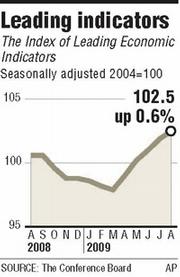NEW YORK — A private forecast of economic activity rose in August for the fifth straight month, the latest sign the recession has ended.
The Conference Board's leading indicators point to an economy on solid ground early next year, though some analysts caution that a rising unemployment rate will restrain growth.
"These data add further evidence to the growing view (and our long-held belief) that the official end date of the recession is likely to be sometime in the third quarter," wrote Michelle Girard, an economist for RBS Securities.
The report "is another signal that economic growth is turning sharply positive this quarter," said Dean Maki, chief U.S. economist at Barclays Capital Inc. in New York. "All of the elements for a robust recovery are falling into place. As we look ahead, job losses will end, and the unemployment rate will stop rising, but we're not there yet."
The Conference Board said Monday that its index of leading indicators rose 0.6 percent in August. That follows a 0.9 percent gain in July revised up from 0.6 percent. Economists surveyed by Thomson Reuters had expected an 0.7 percent gain last month.
The indicators are designed to project economic activity in the next three to six months. The August results support many analysts' projections that the economy started growing again in the current July-September quarter and will continue to gain in the fourth quarter.
The recession's end "is no longer a source of heated discussion ... but whether or not the economy can keep grinding forward (and at what speed) is still a big question mark," Jennifer Lee, an economist at BMO Capital Markets, wrote in a note to clients Monday.
Some analysts worry that any current economic growth will falter as unemployment rises from the August rate of 9.7 percent to above 10 percent. Arkansas' unemployment rate fell in August to 7.1 percent from 7.4 percent in July.
The leading indicators provided a rosier outlook for next year, said Bank of America Merrill Lynch analyst Ethan Harris.
"This is good news, no question about it," he said. "The data's more of an argument against the so-called double dip. They're all looking like next year's going to be a solid growth year."
A measure of supplier deliveries, rising stock prices, an increase in consumer expectations, a jump in building permits and the "interest rate spread" boosted the index in August.
That spread is the difference between yields on 10-year Treasuries and the federal funds rate, which the Fed is keeping at a record low near zero.
The funds rate is the interest banks charge each other for loans. A big difference between it and the 10-year Treasury is viewed as positive because investors are willing to lend for longer periods.
The leading indicators index jumped 4.4 percent - an 8.9 percent annual rate - in the six months through August. That's the fastest sixmonth growth rate since March 2004.
The increase in the six months through July was 3.3 percent.
An accompanying index meant to measure the current state of the business cycle was flat in August. The July reading was revised up to a 0.1 percent gain from zero, making it the first increase in nine months.
That index has bottomed in the same month as the U.S. economy for six out of the past seven recessions, Wells Fargo Securities economist Sam Bullard wrote in a research note. "The recent improvement is further evidence that the recession may have ended at the close of the second quarter," Bullard wrote.
The two indices suggest "that the recession is bottoming out," said Conference Board economist Ken Goldstein.
"These numbers are consistent with the view that after a very severe downturn, a recovery is very near," he said. "But the intensity and pattern of that recovery is more uncertain."
The U.S. economy shrank at a 1 percent pace in the second quarter, and analysts predict it is growing at an annual rate of between 3 and 4 percent in the July-September period.
That's an improvement from the large declines in the fourth quarter of last year and first three months of this year which combined for the worst performance in a half century.
Information for this article was contributed by Tali Arbel of The Associated Press, Shobhana Chandra of Bloomberg News and Rex Nutting of Market Watch.
Front Section, Pages 1, 2 on 09/22/2009

